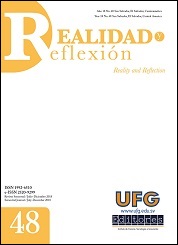Simulation of Retrofitting Utilizing Light Emitting Diode: A Case Study from CA-13 Roadway
DOI:
https://doi.org/10.5377/ryr.v48i0.7084Abstract
This article performs a retrofitting simulation approach using light emitting diode instead of sodium high pressure luminaries; in addition, executes a cost-benefit analysis evaluating technical and economical aspects from the case of study. The illuminance simulation was executed by DIAlux. For performing the study, CA-13 roadway, La Ceiba, Honduras, was selected. The studied roadway is extremely relevant considering that connects with part of the Central American Atlantic region.
Findings from the study demonstrate that although the initial costs of retrofitting conventional lighting to LED are high, the energy and maintenance savings are considerable, and these are the main motivations for why many cities worldwide conduct LED street lighting projects. For the proposed case, the energy consumption saved accounts for 233 MWh (53.3%) annually. Monetarily, savings ascend to USD 38,987 annually compared to the usage of high-pressure sodium lamps (HPS). Financially, this is a viable project, the payback is in 5 years, the NPV is a positive value of USD 196,689, and there is a high IRR of 20.5%, being an attractive percentage for potential investors. Moreover, the benefit-cost ratio equals to 1.83, this value being greater than one, indicates that the project is economically viable. Finally, results from this research indicate that the reduction of GHG emissions by implementing the LED lighting technology would be 77.5 tCO2 annually.
In conclusion, LED roadway lights offer an effective and increasingly cost-effective solution to the development challenge of municipal energy consumption, roadway light network expenditures, greenhouse gases emissions reduction and urban quality.
Downloads
693
Downloads
Published
How to Cite
Issue
Section
License
© Universidad Francisco Gavidia
Instituto de Ciencia, Tecnología e Innovación (ICTI)
Reality and Reflection
The content and opinions expressed in the publication are the responsibility of the authors of the published articles. The authors assign the publishing and publishing rights, in printed and digital version, to the Universidad Francisco Gavidia.
Proof of originality and assignment of publication rights
The authors must sign a certificate in which they indicate that the text presented for publication is original, unpublished and that it has not been sent for review in another academic publication; In turn, the authors assign the rights of publication and publication to Francisco Gavidia University. The format of this record will be sent through the emails: editores@ufg.edu.sv and jlozano@ufg.edu.sv
The journal Reality and Reflection is housed in the institutional dissemination platforms (web page and in the repository), as well as in databases and other pages of scientific dissemination. The publications of the Francisco Gavidia University are subject to the Salvadoran copyright law, contemplated in the Intellectual Property Law https://www.asamblea.gob.sv/
The content of the work is the sole responsibility of the author, therefore, if for any reason or reason, direct or indirect, the Editor is obliged to pay any compensation to a third party derived from the work of the author, whether it is established in a transaction, agreement or final or enforceable judicial sentence, the Editor may repeat against the Author for the total amount of compensation, plus adjustments, interests and costs that correspond.
It will be the obligation of the UFG to grant five copies of the publication which will be delivered at the UFG Editores headquarters in San Salvador.

